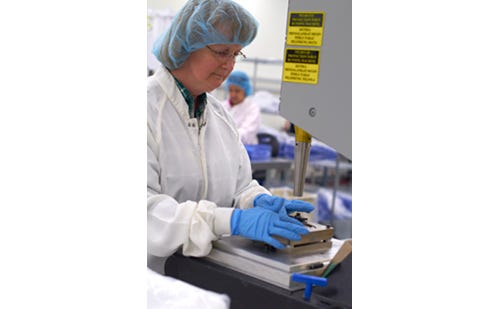Move over, 2-D. New tissue-repair implants come in three dimensions and are customized to specific applications. This product evolution benefits both patients and surgeons, but poses new packaging challenges, according to Rick Crane, vice president, Innovation Services Group, at J-Pac Medical.
April 30, 2014
A J-Pac Medical technician employs a precision thermal process in the manufacture of a custom-shaped implantable medical devices. |
By Camilla Andersson
Contract manufacturers serving the medical device industry often produce 2-D implants, but these implants are not ideally formed for tissue repair or transcatheter delivery, Crane notes, because they don’t conform to the anatomical shapes of the body. Instead, the surgeon typically fashions the implant in the operating room.
In other cases, the medical device manufacturer needs to make adjustments to the products on its manufacturing floor. Because J-Pac’s implants are customized to a specific application, however, they offer benefits not only to the manufacturer, but also to the patient and surgeon, according to Crane.
“[For customized hernia-repair implants] the support for the placement of the product comes from the hernia or the hole itself, not from the surrounding tissue,” Crane explains. “In the past, they needed to put a patch over it and either staple or suture it in place. That created a tension repair and the possibility of having tissue tear and the risk that the implant tears.”
With the 3-D implant, however, surgeons are actually placing the device within the failed area. “It is that structure that is keeping it in place without any need for attachment,” Crane says. “It allows for much less tension in the repair, which has a much better surgical outcome for the patient.”
But a 3-D implant requires 3-D packaging. While flat implants often are packaged in peelable medical pouches, a 3-D implant is typically placed in a rigid tray. The tray helps to maintain and protect the shape of the product. Depending on the material, protecting the implant can create some packaging challenges, Crane says.
“It will only create difficulties if you are dealing primarily with an absorbable polymer in a 3-D shape,” Crane notes. “You have to provide a barrier package for that product. The barrier package materials for a tray are a little more inventive than the barrier package you would include for a pouch… If you have a tray you are going to move into some more exotic forming plastics like Barex in order to get the barrier properties that you need. From the material perspective there can be some challenges when you move into a tray.”
J-Pac makes tissue repair implants in materials such as textiles and polymers. While the products are customized to specific applications, not individual patients, Crane looks to the orthopedic industry for inspiration for the future. He sees potential in the industry’s trend to cut, shape, and personalize implants to a patient’s individual anatomy and says J-Pac’s technology is transferable to such scenarios.
“People have been living in two dimensions for a long time,” Crane says. “If you think of any product that is out there that is provided in a length-and-width shape, if it’s used in surgical repair, wound care, burn treatment, plastic surgery, you name it –literally all of those products could be shaped to fit some sort of anatomical need.”
Get access to medical packaging-related webinars, white papers, and resources in the Medical Packaging Community. |
Camilla Andersson is a contributor to MD+DI.
About the Author(s)
You May Also Like

